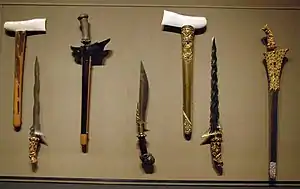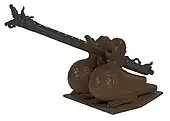| Dohong | |
|---|---|
 A Dohong dagger of Ngaju people. | |
| Type | Dagger, short sword |
| Place of origin | Borneo (Indonesia, Malaysia) |
| Service history | |
| Used by | Dayak people (Ngaju people) |
| Specifications | |
| Length | approximately 45 cm (18 in) |
| Blade type | Single edge |
| Hilt type | Wood, horse or goat hair |
| Scabbard/sheath | Wood |
The Dohong (also Duhong or Duhung) is a dagger or short war sword from Borneo. The name is used figuratively to imply bravery. In other parts of Borneo, it is simply referred to as Mandau.[1] The Dohong is considered an ancient Dayak sword that was used long before the Mandau was introduced.[2] It is believed to be the oldest weapon of the Dayak people.[3] According to folklore, the first people who owns the Dohong are the forefathers of Dayak people, namely Raja Sangen, Raja Sangiang, and Raja Bunu.[4]
Description
There are two types of Dohong. One version serves as a combat weapon, and the other as a ceremonial weapon:-[5]
The Dohong has a double-edged, leaf- or wedge-shaped blade. The blade widens from the hilt to the end-tip. The tip is pointed. The blade usually has a central ridge and looks similar to a spearhead.[6] There are different versions that differ in shape, hilt and decoration. There are blades that represent a figure with arms and legs. The hilt, without guard, is often decorated with feathers and is made of wood or antler.[7] The scabbards are made of wood and made of two halves. They are held together with rattan straps. The surfaces are decorated with carvings, often depicting a face.[5]
In contrast to the normal Dohong, the handle and the blade are made differently. The blade is worked out into a figurative representation, as is the hilt. The scabbard is made of wood and is carved with a depiction of a face. The ceremonial dohong is used in mourning ceremonies and worn by women when warriors return from headhunting to the village. Amulets made of shark teeth or bear claws are often attached to the belts that holds the Dohong.[5]
See also
References
- ↑ George Cameron Stone (2013). A Glossary of the Construction, Decoration and Use of Arms and Armor: In All Countries and in All Times. Dover Publications. p. 212. ISBN 978-04-861-3129-0.
- ↑ Jan B. Avé & Victor T. King (1986). People of the Weeping Forest: Tradition and Change in Borneo. National Museum of Ethnology. p. 59. ISBN 978-90-713-1028-7.
- ↑ Dwi Fajar Sejati (1986). RPUL untuk SD/MI Kelas 4, 5, & 6. Bmedia. p. 129. ISBN 978-60-267-2506-6.
- ↑ Silmi Nurul Utami (20 May 2021). Serafica Gischa (ed.). "Senjata Tradisional Khas Kalimantan Barat". Kompas. Retrieved 2023-09-11.
- 1 2 3 Albert G Van Zonneveld (2002). Traditional Weapons of the Indonesian Archipelago. Koninklyk Instituut Voor Taal Land. p. 42. ISBN 90-5450-004-2.
- ↑ Maulana (12 June 2020). "Pembuatan Pedang Dohong Khas Suku Dayak Tertua Dari Mandau". Teras7. Retrieved 2023-09-11.
- ↑ "Senjata Tradisional Kalimantan Barat, Ini 3 Jenisnya". Kumparan. 20 July 2021. Retrieved 2023-09-11.


